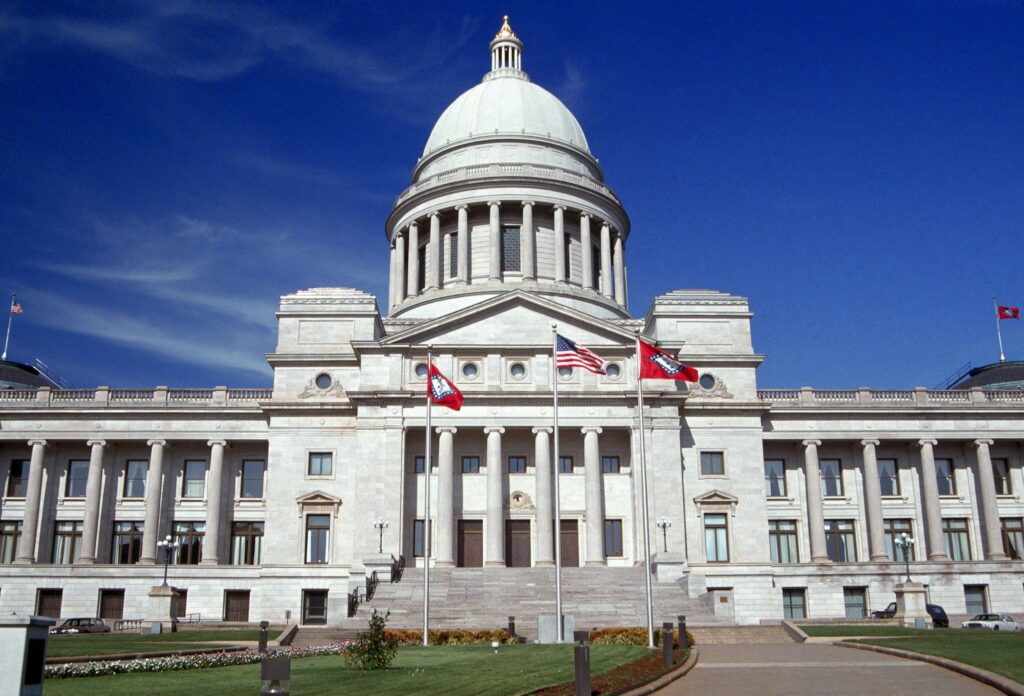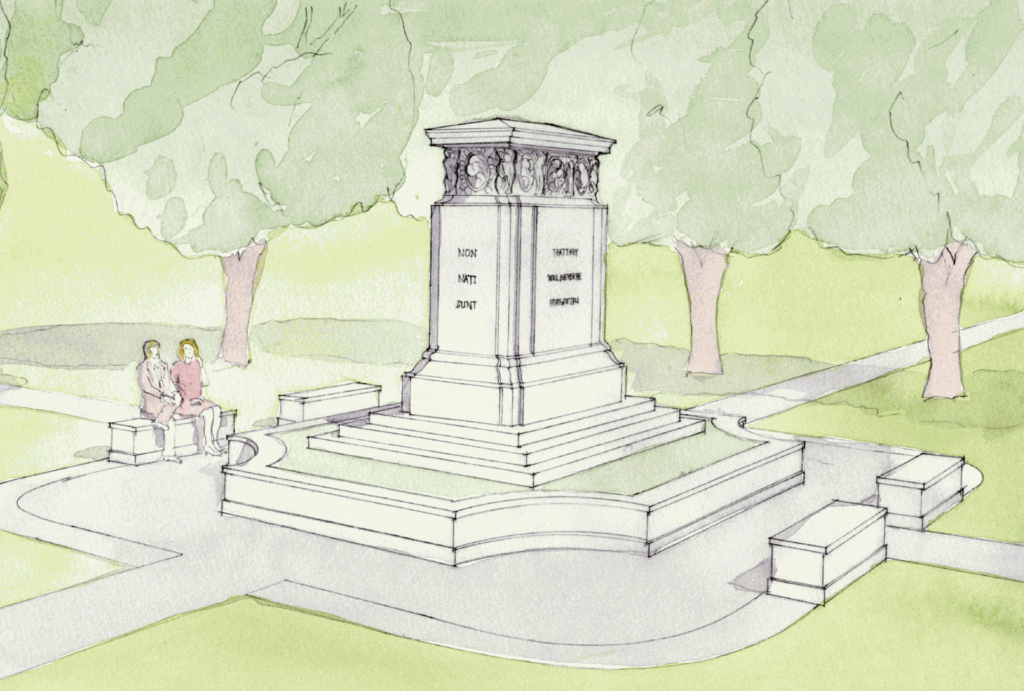More than Missionary
The Mourning After
The Arkansas legislature approved plans for a memorial to “unborn children” terminated “during the era of Roe v Wade”

(Arkansas state capitol building. Image source: The Guardian)
What does it mean when a state plans to memorialize the unborn? For over half a century, anti-abortion activists have inserted their restrictive theology into the public square, social policy, and the intimate spaces of our reproductive lives. In so doing, these devout activists have attempted to control not just our bodies and our healthcare, but the stories we tell about them. Fetal imagery has been essential to this religious and political undertaking.
In the wake of the 2022 Dobbs decision, and especially in states with abortion bans, the public culture of the anti-abortion movement is taking on new state-sponsored forms. As much is apparent in Arkansas, where the legislature recently approved plans for a memorial to “unborn children” terminated “during the era of Roe v Wade.” In the past, anti-abortion legislators have used fetal burial laws to compel health care providers and pregnant people to cremate or bury fetal remains rather than treating this tissue as medical waste. Critics have argued, often in court, that such funerary laws are meant to impose a religious viewpoint about fetal life and mandate a mourning ritual for aborted or miscarried “babies.” So too with Arkansas’ state-sponsored monument to the unborn, the first of its kind to be commissioned after Dobbs. The cenotaph, however, does more than magnify and legitimize the anti-abortion movement’s demand that we view abortion as a loss of human life. It also proclaims that “the natural state” is a Christian dominion.
The anti-abortion movement has long created a rich material culture in service of its doctrine that the fetus is a child and abortion is murder. Opponents of abortion unceasingly and graphically convey this belief in prefabricated packets for Sanctity of Life Sundays, white crosses on church lawns, signs carried by street preachers outside abortion clinics, billboards on the side of major thoroughfares, and countless other forms of ephemera. Through these fetal fetishes, anti-abortion activists invite us to join them in grieving the loss of human life and stopping an “abortion holocaust.” The movement’s dream was to see Roe v Wade overturned. Until then, proselytization was the name of the game.
But in Arkansas, where an abortion ban went into effect within hours of the Dobb’s ruling, “pro-life” partisans are no longer an oppositional force and no longer need only to proselytize. Now, they are stewards and defenders of a restrictive abortion law. The planned monument–an expression of “pro-life” triumphalism–is nothing less than an attempt to legitimize this new and restrictive reproductive regime. Memorials, after all, are powerful public statements. They convey an “official” story about our bodies, our selves, and our pasts even as they (literally!) concretize a select set of values for future generations. In the plans for a state-sponsored abortion memorial, we see an aspiration for an enduring Christian dominion over reproduction.

(One of the proposals for the memorial to the “unborn.” Image source: Arkansas Advocate)
The content and placement of this abortion memorial signal Arkansas’ enshrinement of a white Christian nationalist worldview. The monument will be located at Arkansas’ state capitol and will likely sit near a controversial statue of the Ten Commandments, and a Confederate War Memorial. Despite several design proposals that featured images of unborn bodies, there will be no graphic fetal iconography at the memorial. The current plans for the monument include a living wall of greenery that is intended, in the words of its designer, to “honor God, the Creator & the unborn.” It will also feature a plaque with scripture (Psalm 145:8, NAB) and a quote derived from Amendment 68 of the Arkansas Constitution, stating that it is “the policy of Arkansas to protect every unborn child from the moment of conception until birth.” The absence of fetal bodies–heretofore the centerpiece of the anti-abortion movement–is supplemented with religious text, which states, in effect, that there is no daylight between the beliefs of the anti-abortion movement and state policy.
As evidenced by the memorial, anti-abortion adherents proclaim that fetuses terminated during the Roe era were murdered children, and that the era of legal and accessible abortion is a thing of the past. But that explanation is far too tame. The monument aims to make concrete what the new abortion restrictions assume: that abortion is an atrocity of a recently bygone era that must never return. Arkansas State Representative Cindy Crawford summarized the monument’s mission in the following way: “We have to remember abortion in Arkansas so it won’t come back.”
Predictably, this monument, which emphasizes the unborn and not the bodies that carry them, also erases women, their reproductive histories, their urgent social and medical needs, their dreams, and their diminishing ability to freely author their reproductive futures in Arkansas.
The monument also excludes the many citizens who hold other faiths and believe that reproductive choice is sacred. It is not hard to see how the monument’s very location, its placement at the capitol, and its incorporation of scripture, all trumpet a conservative Evangelical vision. As such, literary scholar Courtney R. Baker’s insight into Confederate monuments holds true for the planned abortion memorial: “The dominant message does just that: it dominates. It does not necessarily convince.” Like the Confederate memorial it will neighbor, the memorial to the unborn is ultimately meant to ossify a slanted story about the past and to limit the possibilities of reproductive freedom in the future.
But this attempt to foreclose reproductive freedoms and erase the voices of dissenters is just that, an attempt. Even as the state of Arkansas is demanding that its citizens grieve the fetuses that were legally terminated during the Roe era, a referendum drive is underway to enshrine reproductive rights into Arkansas’ constitution. If it passes, the ballot initiative will prevent the state from being able to “prohibit, penalize, delay, or restrict abortion services within 18 weeks of fertilization.” It will also allow abortions to protect the health and life of the mother or in cases of incest, rape, or fatal fetal anomalies. In the words of one of the referendum organizers, “we are one step closer to restoring the freedom that was taken from individuals when Roe v. Wade was overturned.”
What does it mean then, that Arkansas’ Republican-dominated legislature plans to memorialize the unborn? Tombs, scholar Benedict Anderson once observed, are integral to nation-building projects. “No more arresting emblems” exist, he asserts, than such edifices, which are, “saturated with ghostly national imaginings.” Such shrines, he notes, invite citizens to sentimentally identify with cultural projects far larger than themselves. In Arkansas, the planned memorial to the “unborn” is meant to entomb abortion rights and raise the flag of Christian nationalism. But that burial is premature. The future of reproductive freedom is still uncertain. It remains unclear what the mourning after Dobbs will look like and what may yet emerge from the rubble of Roe.
Gillian Frank is a historian of religion and sexuality who co-hosts the podcast Sexing History. His book, A Sacred Choice: Liberal Religion and the Struggle for Abortion Before Roe v Wade, is forthcoming with University of North Carolina Press.